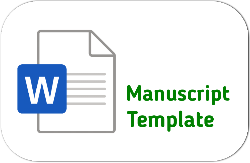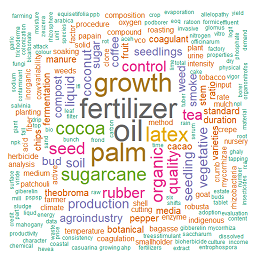Kombinasi Dosis Pemupukan dan Frekuensi Sadap terhadap Produktivitas Individu Tanaman Karet
DOI:
https://doi.org/10.25181/jaip.v11i2.2874Keywords:
fluctuation rubber price, natural rubber, tapping intensityAbstract
Fluctuating rubber prices cause rubber planters to suffer losses, especially when prices are low as of right now. Planters apply high-intensity tapping to obtain maximum production but this is not balanced with optimal fertilization and actually has a negative impact on the sustainability of rubber plantations. The purpose of this study was to determine the effect of a combination of fertilizing doses and tapping frequency on the productivity of rubber plants and to obtain optimal fertilizer doses and tapping frequency when rubber prices are low. The research method used a randomized block design (RBD), with six combination treatments of tapping frequency and fertilization. The results showed that the highest volume of latex was produced in the S/2 d3 ET treatment of 2.5% 100% fertilization, while the variable dry rubber content (DRC), tapping frequency treatment d3 (B, D, F) produced higher DRC and was significantly different compared to tapping frequency treatment d2 (A, C, E). The highest KKK was obtained in treatment F, namely 38.6%. Observation of individual plant production (g per tree per tapping), 50% - 100% fertilization treatment can increase the production of both tapping frequency d2 and d3. The highest production was obtained in treatment F (S/2 d3 ET2.5% 100% fertilization). So, tapping with d3 tapping frequency combined with 100% fertilization dose produces the highest individual plant productivity. Tapping with d3 frequency combined with 50% fertilization can be an alternative when the rubber price is low.Downloads
References
Ahrends, A., Hollingsworth, P. M., Ziegler, A. D., Fox, J. M., Chen, H., Su, Y., & Xu, J. (2015). Current trends of rubber plantation expansion may threaten biodiversity and livelihoods. Global Environmental Change, 34, 48–58. https://doi.org/10.1016/j.gloenvcha.2015.06.002
Andriyanto, M., & Tistama, R. (2014). Perkembangan dan upaya pengendalian kering alur sadap (KAS) pada tanaman karet (Hevea brasiliensis). Warta Perkaretan, 33(2), 89–102. https://doi.org/10.22302/ppk.wp.v33i2.54
Baird, I. G., Noseworthy, W., Tuyen, N. P., Ha, L. T., & Fox, J. (2019). Land grabs and labour: Vietnamese workers on rubber plantations in southern Laos. Singapore Journal of Tropical Geography, 40(1), 50–70. https://doi.org/10.1111/sjtg.12261
Benya, E. G., Lieberman, A. S., & MacDaniels, L. H. (1980). Tree Crops. In BioScience (Vol. 30, Issue 1). https://doi.org/10.2307/1308061
Chambon, B., Dao, X. L., Tongkaemkaew, U., & Gay, F. (2018). What Determine Smallholders’ Fertilization Practices During The Mature Period of Rubber Plantations in Thailand? Experimental Agriculture, 54(6), 824–841. https://doi.org/10.1017/S0014479717000400
Cirad, E. G. (2015). Revised international notation for latex harvest technology. November.
Economics, T. (2023). Rubber Commodity. https://tradingeconomics.com/commodity/rubber
Febbiyanti, T. R., Stevanus, C. T., & Tistama, R. (2021). Peranan Pupuk Dan Fungisida Terhadap Pemulihan Tajuk Akibat Penyakit Gugur Daun Pestalotiopsis Pada Klon Gt 1 Di Kebun Percobaan Pusat Penelitian Karet Sembawa. Jurnal Penelitian Karet, 38(2), 145–164. https://doi.org/10.22302/ppk.jpk.v2i38.705
Grogan, K., Pflugmacher, D., Hostert, P., Mertz, O., & Fensholt, R. (2019). Unravelling the link between global rubber price and tropical deforestation in Cambodia. Nature Plants, 5(1), 47–53. https://doi.org/10.1038/s41477-018-0325-4
Herlinawati, E., & Martini Aji. (2020). Sistem Sadap pada Klon Karet PB 260 dan GT 1 (Hevea brasiliensis) untuk Peningkatan Produksi Lateks. Jurnal Triton, 11(1), 1–6. https://doi.org/10.47687/jt.v11i1.105
Jin, S., Min, S., Huang, J., & Waibel, H. (2022). Rising labour costs and the future of rubber intercropping in China. International Journal of Agricultural Sustainability, 20(2), 124–139. https://doi.org/10.1080/14735903.2021.1918482
Junaidi, Nuringtyas, T. R., Clément-Vidal, A., Flori, A., Syafaah, A., Oktavia, F., Ismawanto, S., Aji, M., Subandiyah, S., & Montoro, P. (2022). Analysis of reduced and oxidized antioxidants in Hevea brasiliensis latex reveals new insights into the regulation of antioxidants in response to harvesting stress and tapping panel dryness. Heliyon, 8(7), e09840. https://doi.org/10.1016/j.heliyon.2022.e09840
Khin, A. A., Bin, R. L. L., Keong, O. C., Yie, F. W., & Liang, N. J. (2019). Critical factors of the natural rubber price instability in the world market. Humanities and Social Sciences Reviews, 7(1), 199–208. https://doi.org/10.18510/hssr.2019.7124
Kouadio, B. E., Marcos, Z., & Irénné, L. M. (2021). Relationship between the Intensity of Latex Harvesting and the Tapping Panel Dryness Expression of Clone GT 1 of Hevea brasiliensis Muell Arg in South-East Côte d’Ivoire. Journal of Advances in Biology & Biotechnology, 6(7), 36–45. https://doi.org/10.9734/jabb/2021/v24i530216
Kullawong, S., Aditto, S., Chambon, B., & Promkhambut, A. (2020). Farmer fertilization practices of mature rubber plantations in Northeast Thailand during a period of low rubber prices. Forest and Society, 4(1), 162–180. https://doi.org/10.24259/fs.v4i1.8980
Lubis, A. F. (2020). Kajian Aktivitas Fisiologis Tanaman Karet (Hevea brasiliensis Muell Arg.) Klon Metabolisme Tinggi Dan Rendah Pada Kejadian Kering Alur Sadap. Disertasi, 1–180.
Nugrahani, M. O., Rouf, A., Berlian, I., & Hadi, H. (2016). Kajian Fisiologis Kering Alur Sadap Pada Tanaman Karet (Hevea brasiliensis). Warta Perkaretan, 35(2), 135. https://doi.org/10.22302/ppk.wp.v35i2.91
Piyatrakul, P., Yang, M., Putranto, R.-A., Pirrello, J., Dessailly, F., Hu, S., Summo, M., Theeravatanasuk, K., Leclercq, J., Montoro, P., & Amancio, S. (2014). Sequence and Expression Analyses of Ethylene Response Factors Highly Expressed in Latex Cells from Hevea brasiliensis. PLoS ONE, 9(6). https://doi.org/10.1371/journal.pone.0099367
Sopheaveasna, M., Phearun, P., Gohet, E., Lacote, R., Snoeck, D., & Lim Khan Tiva, R. I. (2019). Fertilizer application on immature rubber. The case of clone PB 330 in Tboung Khmum Province, Cambodia. International Rubber Conference 2019, IRRDB, 7 p. http://agritrop.cirad.fr/593891/1/Mak et al 2019.pdf
Soumahin, E. F., N’dri, A. A. E., Ezo, K. M. C., Kouadio, Y. J., & Obouayeba, S. (2022). Agronomic and Financial Assessment of a Tapping System Reducing the Shortage of Tapping Labour in Rubber Tree Cultivation in Southeastern Côte d’Ivoire. Journal of Experimental Agriculture International, 44(10), 194–203. https://doi.org/10.9734/jeai/2022/v44i1030894
Suherman, C., Dewi, I. R., & Wulansari, R. (2020). Pengaruh metode aplikasi dan dosis stimulan cair terhadap produksi lateks pada tanaman karet Klon PR 300 umur 25 tahun. Kultivasi, 19(1), 1023. https://doi.org/10.24198/kultivasi.v19i1.23586
Tounkara, A., Clermont-Dauphin, C., Affholder, F., Ndiaye, S., Masse, D., & Cournac, L. (2020). Inorganic fertilizer use efficiency of millet crop increased with organic fertilizer application in rainfed agriculture on smallholdings in central Senegal. Agriculture, Ecosystems and Environment, 294(May 2019). https://doi.org/10.1016/j.agee.2020.106878
Widyasari, T., & Rouf, A. (2017). Pengaruh Produktivitas Terhadap Harga Pokok Kebun Karet Di Jawa Tengah. Jurnal Penelitian Karet, 1(1), 93–102. https://doi.org/10.22302/ppk.jpk.v1i1.327
Wijaya, T., Ardika, R., & Saputra, J. (2014). The Effect of Omission Fertilizer Application on Rubber Yield of PB 260. Current Agriculture Research Journal, 2(2), 68–72. https://doi.org/10.12944/carj.2.2.01
Yang, H., Sun, Z., Liu, J., Zhang, Z., & Zhang, X. (2022). The Development of Rubber Tapping Machines in Intelligent Agriculture: A Review. Applied Sciences (Switzerland), 12(18). https://doi.org/10.3390/app12189304
Downloads
Published
How to Cite
Issue
Section
License
Copyright (c) 2023 Yoga Bagus Setya Aji, Mudita Oktorina Nugrahani, Riko Cahya Putra

This work is licensed under a Creative Commons Attribution-ShareAlike 4.0 International License.
Authors who publish with Jurnal Agro Industri Perkebunan agree to the following terms:
Authors retain copyright and grant the Jurnal Agro Industri Perkebunan right of first publication with the work simultaneously licensed under a Creative Commons Attribution License (CC BY-SA 4.0) that allows others to share (copy and redistribute the material in any medium or format) and adapt (remix, transform, and build upon the material for any purpose, even commercially) with an acknowledgment of the work's authorship and initial publication in Jurnal Agro Industri Perkebunan.
Authors are able to enter into separate, additional contractual arrangements for the non-exclusive distribution of the journal's published version of the work (e.g., post it to an institutional repository or publish it in a book), with an acknowledgment of its initial publication in Jurnal Agro Industri Perkebunan. Authors are permitted and encouraged to post their work online (e.g., in institutional repositories or on their website) prior to and during the submission process, as it can lead to productive exchanges, as well as earlier and greater citation of published work.


























